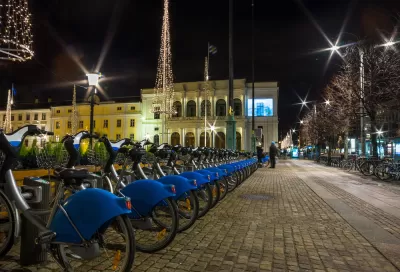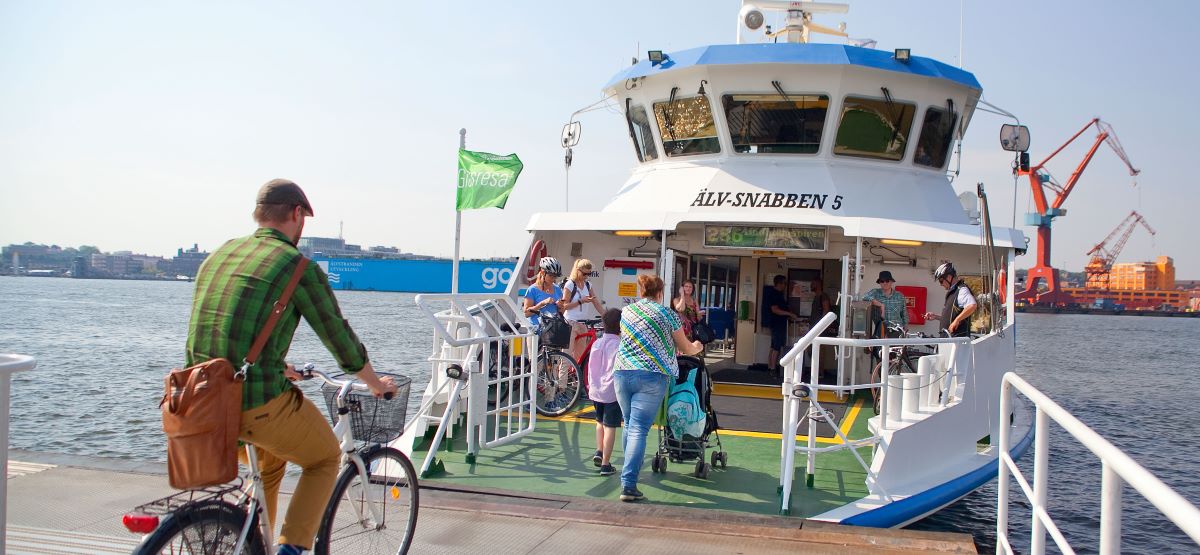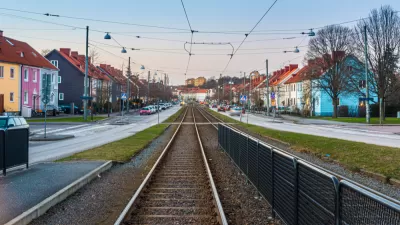Smart cities around the world are finding creative ways to make walking, cycling, public transit, carsharing and delivery services more attractive and efficient. Way to go!

Greetings from Göteborg (also spelled, Gothenburg), Sweden, where I recently spoke about sustainable city planning at the Mobility in Smart Cities Symposium. Göteborg is an amazing city which is applying very smart planning. Let me share some highlights.
In 2013, Goteborg, with just over a half-million residents, became the world’s smallest city to implement congestion pricing. The city also has an extensive tram system and a new Bus Rapid Transit system that share an extensive network of dedicated traffic lanes that allow public transit vehicles to avoid congestion when traveling through the city.

The city also has a network of ferry boats that carry thousands of pedestrians and cyclists between neighborhoods along its waterfront.

In addition, Goteborg has developed a extensive bicycle route network and bikesharing stations around the city, and during the last decade has redeveloped its downtown core, once crowded with cars, into a grid of cobblestone streets that limit automobile traffic volumes and speeds. It is also applying smart growth development policies and parking management strategies.
The overall result of these policies is terrific: although the city is very modern, dynamic and affluent, it has a low automobile mode share, minimal automobile traffic and attractive streets.
Since Goteborg is the home of the Volvo corporation, I used his opportunity to investigate the state-of-art in clean and quite buses, a critical issue in creating more attractive cities, as Lindy Day recently discussed in her Planetizen blog, City Living Without the Racket.
During the Smart Cities Symposium, Volvo demonstrated its new hybrid electric buses, which include several features to minimize urban noise. These buses have relatively large battery packs plus quick recharging stations at some bus stops, which allow the buses to operate entirely in electric mode in central districts and only use their diesel engines in outlying areas. The manufacture claims that under suitable conditions they have lower total overall operating costs than conventional diesel buses.
I also spoke with leading diesel engineers to find out about other potential ways to reduce diesel bus noise. Buses that meet the new Euro VI standard tend to be quieter than older models, but still noisier than optimal. According to the experts, it is possible to reduce noise even more by designing vehicles with more engine isolation, larger mufflers, different tuning, and active noise suppression. This would moderately increase production costs and may slightly reduce fuel economy, but I suspect the results would be worthwhile because quieter buses would attract more passengers and help create more attractive and compact cities; a 5-10% increase in purchase or fuel consumption would pay for itself if the buses attract 10% more discretionary travellers (people who would otherwise drive).
Of course, Goteborg is not the only city that is using new technologies to help make public transit more attractive. For example, all new buses purchased by the IETT transit agency in Istanbul, Turkey have bike racks, free onboard wifi services and USB ports at each seat, amenities that have minimal extra cost when incorporated into new buses. Other cities are upgrading train stations and bus stops, providing real time train and bus arrival information, and more convenient transit fare payment options.
These are examples of ways that smart cities are making walking, cycling, public transit, carsharing and delivery services, and therefore urban living, more attractive and efficient.

Pennsylvania Mall Conversion Bill Passes House
If passed, the bill would promote the adaptive reuse of defunct commercial buildings.

World's Largest Wildlife Overpass In the Works in Los Angeles County
Caltrans will soon close half of the 101 Freeway in order to continue construction of the Wallis Annenberg Wildlife Crossing near Agoura Hills in Los Angeles County.

U.S. Supreme Court: California's Impact Fees May Violate Takings Clause
A California property owner took El Dorado County to state court after paying a traffic impact fee he felt was exorbitant. He lost in trial court, appellate court, and the California Supreme Court denied review. Then the U.S. Supreme Court acted.

California Grid Runs on 100% Renewable Energy for Over 9 Hours
The state’s energy grid was entirely powered by clean energy for some portion of the day on 37 out of the last 45 days.

New Forecasting Tool Aims to Reduce Heat-Related Deaths
Two federal agencies launched a new, easy-to-use, color-coded heat warning system that combines meteorological and medical risk factors.

AI Traffic Management Comes to Dallas-Fort Worth
Several Texas cities are using an AI-powered platform called NoTraffic to help manage traffic signals to increase safety and improve traffic flow.
City of Costa Mesa
Licking County
Barrett Planning Group LLC
HUD's Office of Policy Development and Research
Mpact Transit + Community
HUD's Office of Policy Development and Research
Tufts University, Department of Urban and Environmental Policy & Planning
City of Universal City TX
ULI Northwest Arkansas
Write for Planetizen
Urban Design for Planners 1: Software Tools
This six-course series explores essential urban design concepts using open source software and equips planners with the tools they need to participate fully in the urban design process.
Planning for Universal Design
Learn the tools for implementing Universal Design in planning regulations.



























